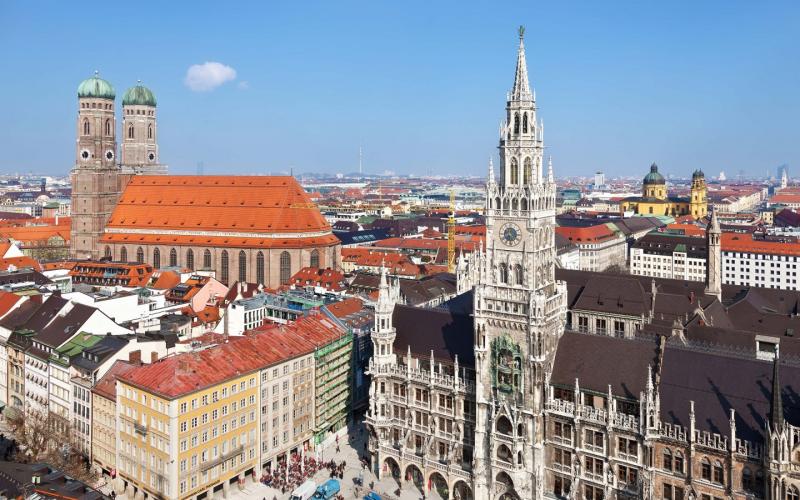
Munich's Architecture
By Sean Mahon
Munich is resplendent with architectural gems, whether it is noble squares, spectacular churches or immaculate palaces there are many sites to see which will aesthetically enrich and awe in equal measure.
Allianz Arena
Built for the 2006 FIFA World Cup, and home of Bundesliga giants Bayern Munich and minnows TSV 1860 Munich, the Allianz Arena has gone on to be one of the most recognised stadiums around the world. A visit here is more than just seeing a football match, you will lay witness to a fine piece of modern German architecture. At a cost of €340 million, an unbelievably slick and curious creation it has been nicknamed the ‘life belt’ and ‘rubber boat’ because of the 2,874 inflated foil air panels which seems each panel lit depending on who the respective home team is. This innovative stadium-facade lighting concept has been subsequently adopted in other newly built venues, like MetLife Stadium near New York City.
Designed by the architects Herzog & de Meuron, with a 69 000 capacity it is located on the edge of northern Munich around 10 kilometres from the city centre. Transportation to the stadium is easy enough, with a direct metro link from the city centre which is only a 20 minute journey. The Allianz Arena offers guided stadium tours that include the changing rooms, players’ tunnel, sponsor lounge, and press club. The tours last about 60 minutes.
Frauenkirche
The landmark of Munich is the Catholic Church of our Blessed Lady – Frauenkirche with its imposing domed twin towers which reach an astounding 100 metres into the sky are the symbol of the Bavarian capital. Built between 1468 and 1488, no other building stands as tall in the city and during the months of April to October you can enjoy breath taking panoramic city views from the South Tower. The triple-naved late-Gothic cathedral lies in Munich's old quarter, and also houses art treasures spanning five centuries. It is the cathedral church of the Archbishop of Munich and Freising.
The instantly recognisable, colossal saddleback roof was erected by Jörg von Hasbach after it needn’t refurbishments following World War Two and today, it stands as one of the largest hall churches in southern Germany. Despite its enormous dimensions, it is the beauty and simplicity of the church which captivates its visitors. The oldest tombs of the House of Wittelsbach are found in the royal vault under the choir, among them Emperor Ludwig the Bavarian and his sons. With a capacity to hold up to 20,000 people, the altars and the side altars, remodelled in the baroque style, are beautiful. This is only matched by the chapels which contain works by various artists, including van Dyck's "Christ on the Cross". It is said that the devil demanded the church be built without windows. When he went inside to inspect whether his demand had been met, he left behind a footprint at the entrance of the church. From the “devil’s footprint” you will see that the devil’s wish was granted and no windows can actually be seen from this point!
Old Town Hall
The Old Town Hall or Atles Rathaus to give it its German title serves as the city’s building for its council. Located on the eastern side of Marienplatz, what stands today is the third incarnation of the building after it was unfortunately struck by lightning in 1460, ruining its medieval origins and faced further hardship when its baroque replacement was levelled by World War Two bombs. The third version of it was designed by the man behind by Frauenkirche, Jörg von Hasbach. The building stands as a gothic homage today, with the statues of Ludwig the Bavarian and Henry the Lion and gable design celebrating the neo gothic roots of the structure.
The plain exterior of the building is completely at odds with the glorious interior which is a masterpiece of medieval design. Boasting a barrel-vaulted timber roof with beautiful decorative beams and golden stars, the inside is truly a marvel to behold. There is also a 55 metre tower which you can climb and enjoy an excellent view of the city from. The Old Town Hall houses the adorable Spielzeugmuseum (Toy Museum) which has a huge collection of rare and precious toys from throughout Europe and the US. The museum traces the history of toys from the early 19th century toys all way the up to the modern toys which dominate children’s wish lists today. A small gift shop on the first floor offers a variety of trinkets and souvenirs.
The Maximilianeum
Commissioned by King Maximilian II in the mid 19th century as an institution of higher learning, the Maximilaneum was completed in 1874, a decade after the King’s death. The design of build was put for competition in order to choose the best design for this structure. Despite producing the winning design, Wilhelm Stier’s proposal was dismissed and instead the project was given to Friedrich Bürklein, who had assisted him with other plans for city growth.
The building is situated on the bank of river Isar before the Maximilian Bridge and marks the eastern end of the Maximilianstrasse. One of Munich's royal avenues, it is framed by neo-Gothic palaces influenced by the English Perpendicular style. Rather than the Maximilianeum being gothic in style as planned, the King decided he preferred a neo-Renaissance design. Therefore, much of the central portion of the building required re-construction. Further problems were created by the sloping terrain along the Isar River, which meant the building’s foundation were difficult to fortify. During the summer, the surrounding park – Maximiliananlagen is descended upon by cyclists.
Share this article:



















